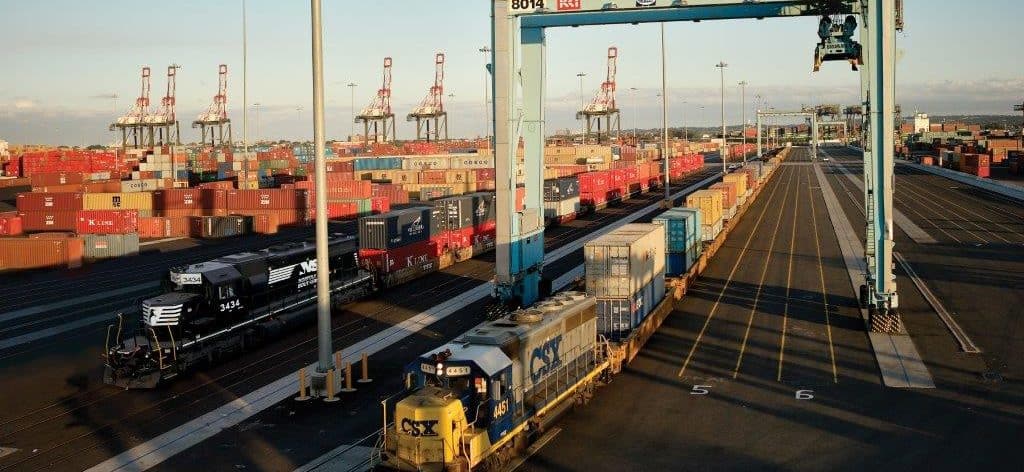
This article brought to you courtesy of NEXT Trucking
Intermodal and drayage carriers are seeing a drop in demand about midway through the second quarter. The U.S.-China trade war gets most of the blame, but it might be more complicated than that.
After 2018’s rush to get containerized goods off of U.S. ports and into warehouses and distribution centers, it’s not surprising that volumes are lower. But market experts see other factors tamping down domestic and international container volumes.
The service shifts at Class 1 railroads are making shippers wary of using intermodal. Some shippers are returning to trucking to move goods rather than container-on-flatcar. The number of outbound loaded containers from U.S. ports are plumbing new lows. Inventories remain high and the rise of warehouses near population centers and ports means containers travel fewer miles.
“Overall, intermodal and drayage, domestic and international, are seeing pullbacks,” said Mike Albert, Chief Executive Officer of Pennsylvania-based freight matching platform DrayNow.
Albert, who has spent over 20 years in the logistics industry, said “the domestic intermodal side saw a slowdown immediately into the new year. The international side was strong up through mid-April.”
The Intermodal Outbound Tender Rejection Index (SONAR: IMOTRI.USA) shows the poor state of intermodal demand.

The index, which measures the ratio of loads a carrier rejects compared to the total loads tendered, is down some 60 percent from the start of the year.
Tom Adamski, an agent with New Jersey-based First Coast Logistics, said the intermodal business “is being impacted by a host of things,” especially the changing business models at Class 1 railroads.
“The railroads through their adoption of precision scheduled railroading (PSR) is changing the dynamics on the drayage end of it,” Adamski said.
PSR, or its variants, are cited as reasons behind the closure of rail ramps and intermodal yards and major service changes.
Albert agrees that “there’s been a lot of changes in the rails and people are just frustrated.”
The Association of American Railroads (AAR) reported that intermodal units for the week ending May 18 saw a 5.5 percent drop from a year earlier, one of the worse weekly showings since April. Year-to-date intermodal units are down close to 2 percent, AAR reported.
But Albert said those numbers understate the true volume drop, since it also counts repositioning empty containers.
“The industry as a whole is down 15 percent to 25 percent versus last year,” he added.
Some of the volume has gone to over-the-road (OTR) trucking as “the negative noise about rail has pushed people to see OTR as a viable option,” Albert said.
The 20 percent drop in U.S. dry van freight rates (SONAR: DATVF.VNU) from the start of 2019 also helps shippers make the switch, Albert said.
He said the switch to OTR is just a blip in the long-term uptake of intermodal. But “the cost break is so close on some lanes that a shipper figures it’s just easier with OTR,” Albert said.

(SONAR: DATVF.LAXDAL, INTRM.LAXDAL)
As with the domestic side, international containers are also seeing less demand. A New Jersey-based intermodal agent, who spoke on condition of anonymity, said “universally, everyone is slow.”
“The cans at the (Port of New York and New Jersey), they’re slow,” he said. “I’m not even getting rate enquiries.”
The first quarter of 2019 was mixed for international containers. The main U.S. East Coast ports saw a 6 percent year-on-year increase in loaded imports. But the U.S. West Coast ports saw overall relatively flat import volumes.
The real weakness is in loaded exports. The first quarter of 2019 saw an 11 percent drop in loaded exports at major U.S. ports compared to the year earlier. The intermodal agent said a regional leather exporter has seen their export business sharply decline.
The third largest port in the U.S., New York and New Jersey reported a 2 percent decline in loaded export volumes for the first quarter. The biggest jump was the number of empty containers the port is handling, which rose 19 percent in the first quarter.
As for imports, those grew close to 4 percent overall. But Adamski said the April and May numbers, once in, may show some “wobble” due to lower volumes.
The wobble “has more to do with the inventory levels in warehouses,” Adamski said.
Thanks to pre-buying of containers last year and the growth of e-commerce, “demand for warehouses in New Jersey is sky high,” Adamski said.
He said carriers are not yet responding to weaker drayage demand by lowering their rates. But some owner-operators and independent drivers are coming in with 10 percent lower bids on container moves.
“There’s not excess to the point of absurdity, but there is a cushion” in supply, Adamski said.
On the domestic side, Albert said most carriers are holding firm on rates. But intermodal brokers have been able to get some loads done up to 7 percent lower than current market rates.
“Everyone was taking huge swings for rates last year and getting them,” Albert said.
“They are hoping to hold on to what they got last year. But given the fuel prices, the contract negotiations with steamship lines, and the tariff issue, something is going to have to give.”
Japanese shipping company cuts executive pay
K-Line implements 10 percent cuts after $1 billion loss last year. (Seatrade Maritime)
Saudi Aramco to lift U.S. LNG
State oil company will buy gas from U.S. supplier for 20-year term out of plant in Texas. (MarineLink)
Bring on the rain, says Panama Canal
Recent showers will help delay latest round of draft restrictions. (Seatrade Maritime)
Refinery restarts may perk up tanker demand
Restart of refineries shuttered for maintenance mean more gas and diesel cargoes. (TradeWinds)











